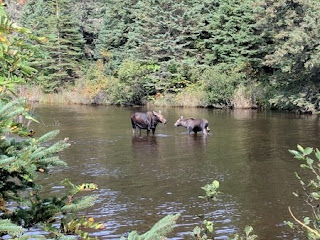This month we are looking at one of the largest mammals in North America, the moose. Since they are
found in the northern areas, I decided the dead of winter is a great time to profile this great beast. If you
are ever lucky enough to see one, they are best viewed from a distance. Size may be deceiving. They
move quickly and won't hesitate to mess you up!
found in the northern areas, I decided the dead of winter is a great time to profile this great beast. If you
are ever lucky enough to see one, they are best viewed from a distance. Size may be deceiving. They
move quickly and won't hesitate to mess you up!
 |
| Moose in Alaska (NPS) |
Scientific name: Alces alces
Kingdom: Animalia (animals)
Class: Mammalia (mammals)
Order: Artiodactyla (even-toed mammals)
Range: Northern North America
Habitat: Forested areas near freshwater
Lifespan: 8-12 years on average
 |
| Moose shedding his antler velvet (NPS) |
Diet: Twigs, bark, and roots of trees- especially aspen, willow, and conifers; aquatic plants during
summer months
summer months
Predators: Wolves, bears (black and grizzly), humans
Conservation Status: Species of Special Concern in Michigan; no special protection in other areas
Other Information: The moose is so cool! Or at least it strives to be. Body size, coupled with an
inability to sweat, means they have to seek shade and water in or to avoid overheating during summer
months. Just how big is a moose? They can grow to be 7 feet tall at the shoulder! Males grow antlers
for mating season and shed them afterwards. Those antlers, largest in the animal world, can span 6 feet.
Calf mortality is high- 50%. Due to their size, calves are more likely than adults to suffer predation by
wolves or bears. Adults are armed with sharp hooves, in addition to those huge antlers on males. Moose
disease is a fatal brainworm parasitic infection, also seen in deer. Ticks also present a problem. They
can weaken a moose to the point of death from blood loss.
Our moose information comes from University of Michigan's Animal Diversity Web.
inability to sweat, means they have to seek shade and water in or to avoid overheating during summer
months. Just how big is a moose? They can grow to be 7 feet tall at the shoulder! Males grow antlers
for mating season and shed them afterwards. Those antlers, largest in the animal world, can span 6 feet.
Calf mortality is high- 50%. Due to their size, calves are more likely than adults to suffer predation by
wolves or bears. Adults are armed with sharp hooves, in addition to those huge antlers on males. Moose
disease is a fatal brainworm parasitic infection, also seen in deer. Ticks also present a problem. They
can weaken a moose to the point of death from blood loss.
 |
| Mama moose with calf in Michigan (NPS) |
Our moose information comes from University of Michigan's Animal Diversity Web.
No comments:
Post a Comment